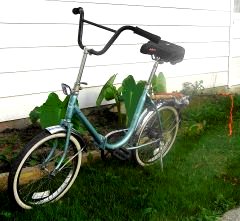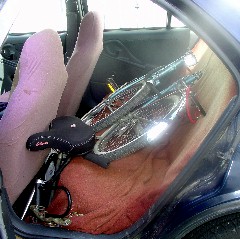My days on the water are a bit more enjoyable since eliminating the 2-4 mile hike downstream to put-in.

The bike shown here is outfitted with a small rack. Tackle and other gear is carried in a typical fishing vest by the angler/cyclist.
Every stream smallmouth bass angler who fishes solo and wants to cover more water than what’s available at bridges or other access points faces the same issue: how do you get from your vehicle (typically left at the take-out spot) back to the put-in spot when wading the stream? Over the years I’ve walked many miles, hitched a ride from passing farmers and motorists, and even used rural ‘Dial-a-Ride’ public transportation, but most often I’d find myself walking the miles back downstream, sacrificing an hour or two of time on the water.
Tim’s first book, “Stream Smallmouth Fishing,” touched briefly on bicycles as a shuttle system, and it was this that finally prompted me to explore using a bike to travel between the take-out and put-in sites. I did a search of the local Craig’s Listing for bicycles, and stumbled upon a perfect fit: The folding bicycle.

All the bike components are pictured here.
Popular with campers for years, a folding bike is a basic bicycle in a small, compact, easily transported package. The bike’s tires are small (about the size of a child’s bicycle) with the seat and handlebars higher to fit an adult. The ride is a bit unstable, but easily learned.
With this folding bicycle shuttle system, a solo stream smallmouth bass angler has easy transportation between the take-out and put-in spots. There’s no need for a bulky, complicated bicycle rack or a full-sized bikes. This bicycle is perfect for the short distances needed to travel between access points on the stream.
Editor’s Note:
No question, a bicycle can be fine alternative transportation, taking the place of second car. The folding bike discussed in this article is not only easy to load into a small car or store in a small space at home, but it can also be hauled in a canoe, a small johnboat or a large pontoon.

With the seat and handlebars removed easily with quick-release levers, the entire bike fits easily into the rear seat of a small four-door car.
Here’s how you could use the bring-the-bike-on-the-float method: You would drop your craft off at the launch site, then drive your car down to the take-out and bike back to the launch. You bring the folded-down bike along on the float. At the end of the day, your craft, bike and tackle are all in the same place, negating the need to drive back to the launch site.
If you have room for a full-sized, non-folding bike, this will also work well as transportation. Naturally, solo anglers have lots of use for bikes, but even with two people a bicycle can be very good. Especially where the drive to the river is long, leaving one vehicle at home and using a bike for the shuttle is very economical.
Generally, a bicycle is good for shuttles up to 7 or 8 miles if the road is paved and the person is in decent shape. Where shuttle distances are long or roads rough and unpaved, two-wheeled transportation isn’t practical. But that still leaves plenty of places where the bike is certainly worth considering.


No comments yet.